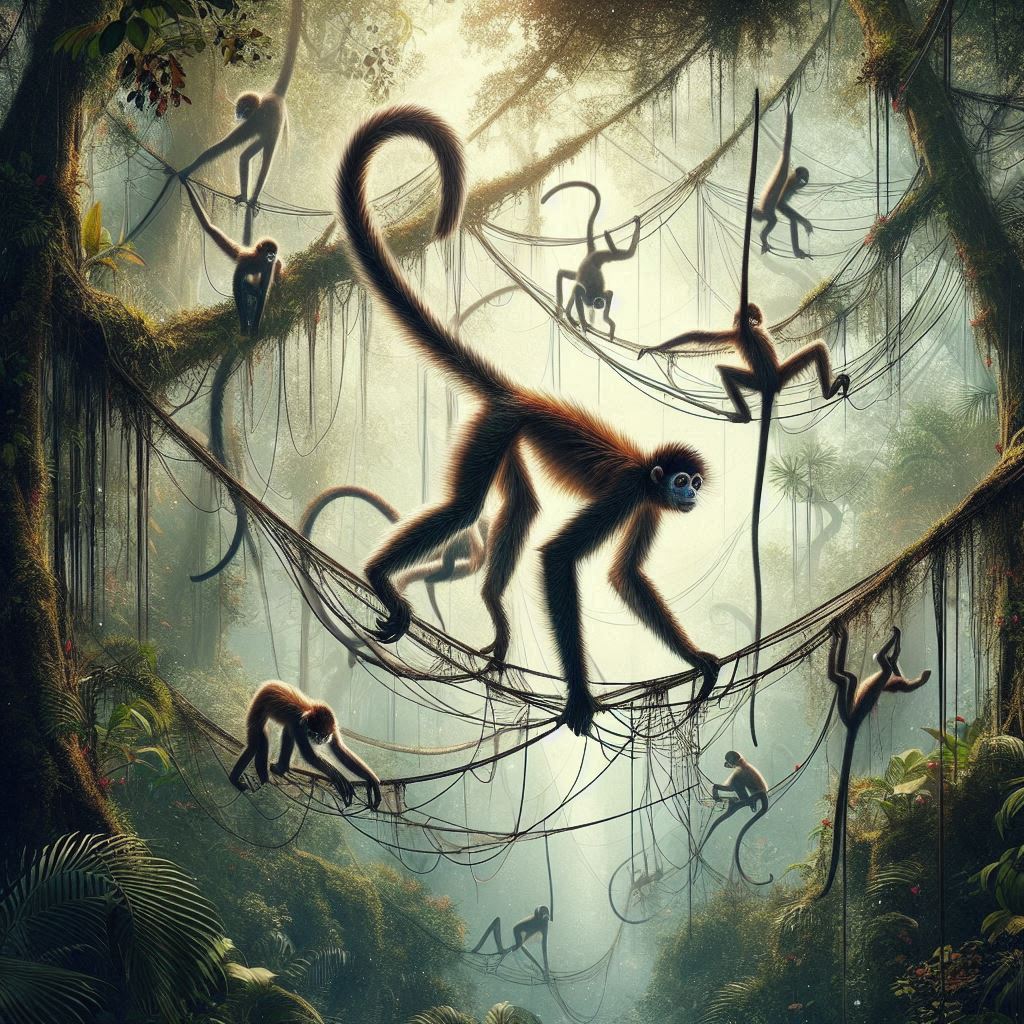
Spider Monkeys: The Acrobats of the Jungle
Share
Spider Monkeys: The Acrobats of the Jungle
Spider monkeys, known for their long limbs and prehensile tails, are among the most fascinating primates in the world. These acrobatic creatures of the jungle are often seen swinging from tree to tree with impressive agility and grace. Native to Central and South America, spider monkeys have evolved to become the acrobats of the rainforest, making their way through the treetops in a manner that almost seems otherworldly. Let’s dive into the world of these remarkable primates and explore what makes them such a key species in their ecosystems.
What Makes Spider Monkeys So Unique?
Spider monkeys are instantly recognizable due to their long, spindly limbs and tail, which is often longer than their body. Their prehensile tail acts as a “fifth hand” to help them navigate the treetops, grasping branches and supporting their body weight as they swing through the jungle. This incredible adaptation allows spider monkeys to move effortlessly from tree to tree, covering great distances in search of food and mates.
Their long limbs, which are about 1.5 times the length of their body, help them reach out and swing with precision. The flexibility and strength of their limbs, coupled with their tail, make spider monkeys the undisputed acrobats of the jungle. These adaptations allow them to live almost entirely in the trees, making them an arboreal species, with the rainforest canopy being their primary home.
Spider Monkeys’ Social Structure
Spider monkeys are highly social creatures, living in large troops typically made up of 10 to 30 individuals. Their groups are often matrilineal, meaning they are led by the females, who play a crucial role in decision-making. These primates rely on their social groups for support, protection, and even foraging. The group structure is complex, with a network of communication through vocalizations, body language, and tail gestures.
Despite their social nature, spider monkeys tend to have a loose and flexible social organization. While they spend a lot of time with their troop, they also enjoy periods of solitary activity. During these times, they may forage alone or engage in personal grooming.
Spider Monkeys: The Ecological Role
Spider monkeys play a significant role in maintaining the health of their forest environment. As frugivores, they mainly feed on fruits, seeds, and nuts, helping to disperse these seeds across the jungle. This seed dispersal helps promote the growth of various plant species, making spider monkeys crucial for maintaining the biodiversity of their habitat.
Their diet also includes leaves and flowers, and they have a particular fondness for the seeds of certain plants. Spider monkeys are often considered the “gardeners of the rainforest” because of their role in seed dispersal, which supports the regeneration of forests. Without spider monkeys and other similar species, the rainforest would struggle to maintain its delicate balance.
Fun Facts About Spider Monkeys
• Incredible Swingers: Spider monkeys use their long arms and prehensile tail to swing from tree to tree in a unique form of locomotion called “brachiation.”
• Prehensile Tail: Their tail is so strong and flexible that it can wrap around branches, allowing them to hang upside down and balance while reaching for food.
• Vocal Communication: Spider monkeys have a variety of vocalizations, including grunts, howls, and screams, to communicate with each other, especially when they are separated.
• Long Lifespan: In the wild, spider monkeys can live up to 30 years, though they are highly vulnerable to poaching and habitat loss.
• Matrilineal Groups: Female spider monkeys typically lead their groups, making decisions about movement and foraging.
Spider Monkey Conservation: Threats and Challenges
Unfortunately, spider monkeys face numerous threats in the wild. Habitat destruction is the primary concern, as deforestation in Central and South America continues to threaten the rainforest ecosystem. Logging, agricultural expansion, and illegal hunting have led to a significant decline in spider monkey populations. In some areas, they are classified as endangered or critically endangered.
Conservation efforts have been implemented in several regions, focusing on preserving the rainforests, preventing illegal hunting, and protecting the natural habitats of spider monkeys. Education programs have also been launched to raise awareness about the importance of protecting these incredible animals.
The Future of Spider Monkeys
While spider monkeys are under threat, there is hope for their future. Conservation organizations, governments, and local communities are working together to create protected areas and reserves where spider monkeys can thrive without the threat of habitat destruction. By continuing these efforts, we can ensure that spider monkeys remain the acrobats of the jungle for generations to come.
Celebrate the Spider Monkey
If you’re fascinated by the incredible agility and acrobatic skills of spider monkeys, why not show your appreciation with a T-shirt or design inspired by these unique creatures? Spider monkeys’ long limbs and prehensile tails make them an iconic symbol of the rainforest, and their story of survival and adaptability serves as an inspiration to conservationists around the world.
CyberMutz.com (Dog-Themed Apparel & Accessories)
“CyberMutz.com – Explore a unique collection of dog-themed apparel, accessories, and gifts for pet lovers. Shop stylish, high-quality designs featuring your favorite dog breeds!” Category Page Descriptions: Dog Breed T-Shirts: “Show off your love for dogs with our exclusive breed-themed T-shirts. From German Shepherds to Chihuahuas, find high-quality, comfortable tees celebrating your favorite pup!” Dog Breed Pet Tank Tops: “Keep your furry friend stylish and comfortable with our dog breed-themed pet tank tops. Perfect for small and large dogs, these unique designs are a must-have!” Funny Dog-Themed Apparel: “Love dogs and humor? Our funny dog-themed apparel blends style with witty canine-inspired designs. Shop now for T-shirts, hoodies, and more!” Personalized Dog Merchandise: “Customize your dog lover’s gear with our personalized pet-themed apparel and accessories. Create a one-of-a-kind look for yourself or a perfect gift for a fellow dog enthusiast!”
CyberPussyKatz.com (Cat-Themed Apparel & Accessories)
“CyberPussyKatz.com – Celebrate your love for cats with our premium collection of feline-inspired apparel and accessories. Purr-fect designs for every cat lover!” Category Page Descriptions: Cat Breed T-Shirts: “Showcase your favorite feline friend with our stylish cat breed-themed T-shirts. From Maine Coons to Siamese, find the perfect tee for cat lovers!” Funny Cat-Themed Apparel: “Express your quirky side with our funny cat-themed T-shirts, hoodies, and more. Pawsome designs for those who love cats and humor!” Personalized Cat Merchandise: “Make it personal with custom cat-themed apparel and accessories. Create a unique gift or a special piece just for you!”
CyberMunkiez.com (Monkey-Themed Apparel & Accessories)
“CyberMunkiez.com – A fun collection of monkey-inspired apparel and accessories. Perfect for primate lovers who enjoy bold, playful, and unique designs!” Category Page Descriptions: Monkey-Themed T-Shirts: “Go bananas over our monkey-themed T-shirts! Whether you love capuchins, chimps, or gorillas, our designs bring out your wild side.” Funny Primate Apparel: “Add a touch of humor to your wardrobe with our hilarious monkey and ape-inspired apparel. Great for animal lovers and jungle enthusiasts!” Custom Monkey Merchandise: “Make it yours! Personalize your favorite monkey designs on T-shirts, hoodies, and more for a one-of-a-kind look.”
